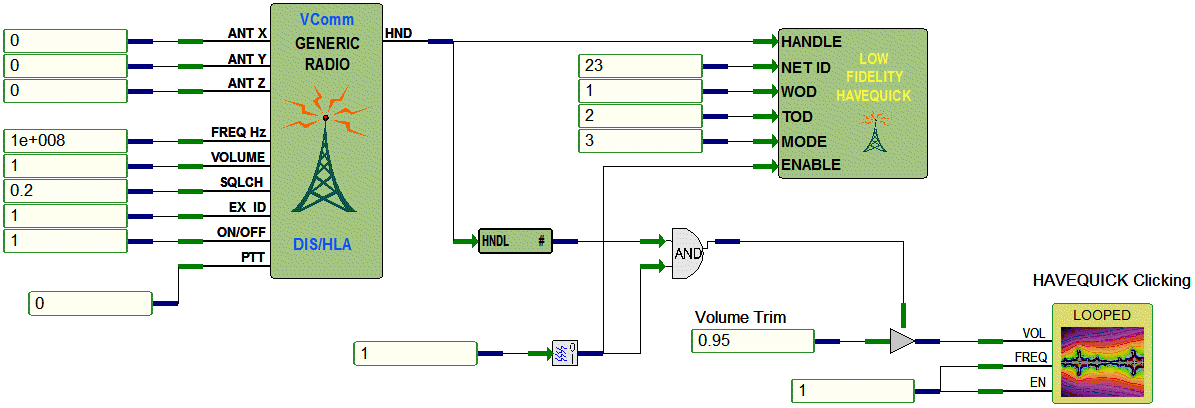|
|
VComm HAVEQUICK |
|
ID: 2050 |
|
|
VComm HAVEQUICK |
|
ID: 2050 |
|
Object Description |
|
|
The VComm HAVEQUICK object can be used in conjunction with VComm Radio Objects to simulate Low Fidelity HAVEQUICK as defined in the IEEE DIS Standard. In order to receive a valid HAVEQUICK transmission, the NET ID, WOD, and TOD must match exactly with the transmitting radio. However, if the WOD and TOD are set to zero on the transmitting or receive side, then a match condition is assume to exist. If the enable pin is greater than zero, the HAVEQUICK mode will be enabled and the Transmitter PDU will contain the Low Fidelity modulation parameters. If the Enable pin is zero, the HAVEQUICK mode is turned off and the radio becomes a normal radio without HAVEQUICK modulation parameters in the transmitter PDU. If the NET ID is zero, this has the same effect as setting the Enable pin to zero. When HAVEQUICK is enabled, the transmit/receive frequency is set to 312.5 MHz automatically and will override any frequency set on the radio. When the enable is turned off, the radio switches back to the frequency set on the radio. This has been established by the CAF DMO organization as a de-facto standard. There is no concept of frequency hopping using HAVEQUICK on DIS/HLA networks. To use the object, simply connect the radio handle output of a radio object to the radio handle input of this object. The data that is present on the input pins is sent to the radio object and can be changed while V+ is running. |
|
|
Special Usage Notes |
|
Frequency: 312,500,000 Hz (312.5 MHz) Bandwidth: 12,500 Hz (12.5 KHz) Power: 40 dBm Major Modulation: 1 (Amplitude) Detail Modulation: 2 (AM) Note that the Modulation System will be set to whatever the MODE pin is set to. All of these values will return to whatever they were prior to the object being enabled.
|
|
|
Input Pins |
|
|
HANDLE |
Radio HANDLE from either the VComm GENERIC Radio, V8 DIS Only or VComm GENERIC Radio, V8 DIS/HLA objects. |
|
NET ID |
The NET ID pin accepts any integer value in the range of 0 to 65,535. A value of 0 disables HAVEQUICK operation. |
|
WOD |
The Word Of Day pin accepts any integer value in the range of 0 to 65,535. |
|
TOD |
The Time Of Day pin accepts any integer value in the range of 0 to 65,535. |
|
MODE |
The MODE pin determines which of the following Modulation System values to engage when HAVEQUICK is enabled (any other values will be ignored): 2 - HAVEQUICK 3 - HAVEQUICK II 4 - HAVEQUICK IIA Note: Currently, modes 2, 3, and 4 are interoperable with each other. |
|
ENABLE |
The ENABLE pin enables the object to simulate HAVEQUICK frequency hopping for a secure radio. A value of 0 disables it. Any non-zero value enables it. |
|
Example |
|
|
In this example, a DIS/HLA radio is connected to a VComm HAVEQUICK object. The NET ID is set to 23, the WOD to 1, the TOD to 2 and the MODE to 3 (HAVEQUICK II). A VComm Get Number of Incoming Transmitters object is attached to the radio so as to determine if a transmission is being received. This is ANDed with an enable constant to turn on the Looped wavefile players volume which produces a clicking noise. The clicking noise simulates the frequency hop of a secure radio. |
|
